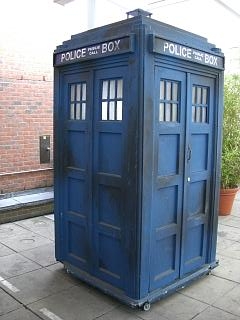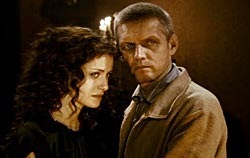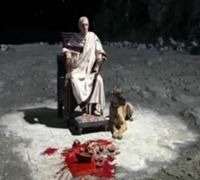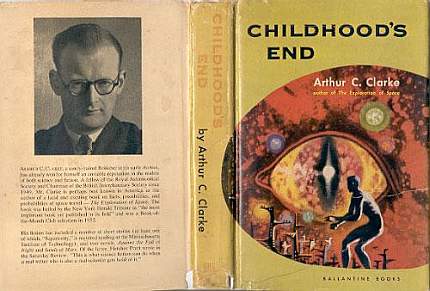= ASTRONAUTICAL EVOLUTION =
Issue 77, 1 January 2012 – 43rd Apollo Anniversary Year
All textual content is by Stephen Ashworth, Oxford, UK,
unless attributed to a different signed author.
Images are credited when the source is known.
=============== AE ===============
In search of a unified worldview:
Bulgakov’s “Master and Margarita”
and Clarke’s “Childhood’s End”
The attempt to find a unified theory of fundamental physics has been a major theme of the past century of scientific research. The goal has been to reconcile the great theories of general relativity, dealing with gravity and the overall structure of the universe, and quantum electrodynamics, dealing with electricity, magnetism and the micro-universe of particles of matter.
Another great theoretical divide which has sometimes been commented on (for example, by Rupert Sheldrake) is that between fundamental physics itself and the sciences of evolutionary complexity. Physics operates on a paradigm of eternal laws which are instantiated in different ways over time, but are themselves immutable and precise. Cosmic and biological evolution take a different point of view: the phenomena which they examine change over time in such a way as to enable entirely new possibilities, the most significant clearly being the appearance of life itself. While chemistry and biology are still based on physics, the products of their evolution – planets, species, civilisations – cannot be predicted from knowledge of physics alone. And while physics offers exact solutions, at least for simple systems, astronomy and biology are historical sciences which depend on the reconstruction of complex chains of events, in which mathematical laws combine with random happenstance to produce unique outcomes.
Moving onto a personal level, I have now found an analogous conflict between two parts of my own worldview.
It began when during the autumn I was thinking about interstellar travel, and realised that the best means to do this which has yet been conceived is Dr Who’s machine, the Tardis. You simply press a few buttons and levers on the control panel, and the ship dematerialises from, say, present-day Earth, and a few minutes or hours later rematerialises on, say, the remote world of Skaro in the distant future.
How might this work in practice? Basically, it wouldn’t. It’s very much like the transporter beam in Star Trek: easy to visualise, impossible to design in light of the physics of the real universe as we know it today.

Assuming that after it dematerialises the Tardis is located in some parallel universe, outside our own spacetime continuum, then one has to ask how it propels itself in that parallel universe, and how it steers. Given that almost every possible location in our universe at which the Tardis could rematerialise consists of empty interstellar or intergalactic space, and almost all the rest of the possible landing-sites are deep within the fiery envelopes of stars or subterranean depths of planets, and that even the surfaces of almost all terrestrial-type planets in the universe are either open to the vacuum of space, like our Moon, or subject to impossible heat or pressure as is the case on Venus, then the trick of finding one of the very few Earth analogue planets, matching its velocity within a fraction of a metre per second and rematerialising with the bottom of the Tardis aligned within a millimetre of a solid surface strong enough to support its weight appears to be miraculous.
The point I take away from this is the enormous contrast between what is easy to imagine, and what is actually possible in practice.
Technology is the only way we have of bringing the visions of the human imagination to life in the real world, but what an indirect, clumsy and weak method that is!
More recently, I spent the Xmas–New Year holiday renewing my enthusiasm for the remarkable Russian novel The Master and Margarita, by Mikhail Bulgakov. A Russian TV series of this novel was made in 2005, and is highly faithful to the book. It may be found on YouTube, consists of ten 50-minute episodes, is adapted and directed by Vladimir Bortko, and in my view is brilliantly realised.
The Master and Margarita is set primarily in Moscow in the 1930s (the same time as it was written). The Devil pays a visit to the city in the person of a mysterious Professor Woland, and his encounters and those of his demonic assistants with the Muscovites have the effect of driving the latter crazy. Many of them are despatched to the local psychiatric hospital, severely mentally disturbed, or are arrested by the dreaded NKVD. Two people, however, are proof against Woland’s disturbing power: the Master, and Margarita, who differ from the mass of ordinary people through their selfless love for each other, and through their devotion to a novel which the Master has written.
This novel within a novel is an account of the trial and execution of Jesus Christ, and his relations with the Roman procurator Pontius Pilate. Naturally, in militantly atheistic Soviet Russia it is unpublishable, and the Master’s attempts to publish it lead to his downfall. He, too, ends up in the psychiatric clinic. Although the Master’s novel differs in many ways from the account given in the Bible, in the world of Bulgakov’s novel it is truthful, and the Master has lost his freedom and all prospect of a normal life because of his innate gift for guessing the truth.

In the end the Master and Margarita are saved and reunited by Woland’s intervention. The novel follows them through to their post-mortem existence in a world which is neither heaven nor hell, but a peaceful place of (as per the title of the penultimate chapter) forgiveness and eternal refuge.
I want to highlight the differences between this novel, and the typical science fiction novel, which I also enjoy, and which expresses a vision of the human future in space. Why? Because I believe in that future. But that is an intellectual belief. On an emotional level I find myself responding much more strongly to Bulgakov’s novel. I want to find out why I seem to have a split personality so far as literature with a philosophical point to it goes.
Firstly, I should explain that I was exposed to Christian concepts of divine judgement, heaven and hell, sin and forgiveness and so on during my childhood, but not strongly. After an emotionally traumatic flirtation with Christianity from the ages of about 16 to about 21 I consciously rejected the Christian worldview and the concept of God. I did not, however, entirely reject the possibility of supernatural phenomena out of hand. I have always had a slight residual interest in the possibility of such things.

This is in fact positively demanded by a strictly scientific view of life, because that view makes it clear that one’s knowledge of reality is entirely mediated by the brain. Our sense of reality is in fact not that reality itself but a reconstruction of it from sense impressions which the brain interprets to create an internal virtual world. Anything which fails to be picked up by our senses (an obvious example being radio waves) therefore fails to be incorporated into our reality, unless some device for making it perceptible is used (such as a radio set).
Supernatural phenomena are therefore logically possible, if they are mediated by agents which for whatever reason are not perceptible to us directly and do not normally interact with physical objects which are perceptible. There could, logically, be an invisible person in the room watching me – not a physical person, obviously, but a conscious being whose perception of the local material world would create as little disturbance to that world as my own conscious perception of the state of the small part of my brain accessible to my mind.
If therefore we believe that other people are conscious just as we ourselves are, then that belief already acknowledges the existence of one supernatural phenomenon.
A useful contrast to Bulgakov’s novel is provided by Arthur C. Clarke’s classic science fiction novel Childhood’s End. This too hinges on a visitation by the Devil and portrays supernatural phenomena, though in a very different way from the Russian novel.

Clarke’s Devil is in fact a member of an alien species from another star, not a supernatural being; the Devil of ancient and medieval history is a premonition of the future, not a personage from the past; the visit is overt rather than covert; the devil species – the Overlords – does not possess any supernatural powers; those powers are acquired by a post-human generation on an Earth controlled by the Overlords for that very purpose; Clarke’s Overlords physically resemble the traditional horned, winged figure, while Bulgakov’s Woland and his assistants are fully human in form, though eccentrically dressed; and the end of Clarke’s novel portrays, not the restoration of the status quo, or an afterlife for the main characters, but rather the transformation of humanity into an unintelligibly different order of life beyond even the comprehension of the Overlords, as well as the final destruction of planet Earth and of the original human species altogether.
So we have two novels with broad and intriguing points of contact, yet utterly different in conception, style and purpose.
Let us try to pinpoint the key differences.
Supernatural power. Bulgakov and Clarke are both intrigued by superhuman powers in which technology is simply bypassed by the superior efficiency of the imagination. Like the use of the Tardis in Dr Who, with its magical propulsion and guidance system, or the transporter and warp drive in Star Trek, the telepathic and psychokinetic faculties in these novels dramatise the vast and puzzlingly unaccountable disparity between imagination and reality which (so far as I know) all people experience, if they think about it.
Bulgakov’s Devil and his assistants appear and disappear at will, and cause material objects to do likewise. They have instant and full access to others’ thoughts. Yet their motivations are easy to understand: they are organising a grand party for the dead, Satan’s Ball, and meanwhile examining and testing the living people they come into contact with. Their business is the study of mankind, and they are happy to shamelessly exploit their superior power to make their business fun, an enjoyment which the reader can fully appreciate.
Clarke’s post-humans share similar power, but apply it for reasons which are only hinted at. They have no interest in their human parents or in any humans at all: they are a different, superior species, and are completely unmoved by the sorrow of their parents, many of whom, on realising that they are the last generation of humankind, commit mass suicide. The post-human children are remote and aloof from mankind and from the emotional makeup of mankind, and care not that they have destroyed all the life of their planetary cradle.
The temporal focus. Bulgakov’s novel looks to the past; specifically, to the trial and execution of Jesus Christ. This is used however not in its conventional religious sense, but as an archetype of the relationship between judge and accused, torturer and victim, killer and killed, recognising that both parties do what they have to do. There is no theological good or evil here, no sacred Son of God being sacrificed, but rather fallible people doing the best they can and being forced into conflict by their circumstances and convictions. Bulgakov has no particular view on the future; recalling the past, and portraying its effects in the present, is sufficient for his purpose.
Clarke’s novel is focused on the future: what will become of the human species? He has no need to dwell on past events; projecting the present into the future is sufficient for his purpose.
The human focus. Bulgakov’s novel is about the fate of individuals – particularly of the Master and Margarita, but also of Pilate and Jesus, and to a lesser extent of the more peripheral characters in the story. This makes it necessary for him to take a view on the status of an individual after death. The main characters certainly possess an immortal soul, and continue to exist, think and act after their deaths; Woland and his suite clearly also belong in this post-mortem state.
Clarke, on the other hand, does not take any explicit view on the issue. When his major character Stormgren comes to the end of his years, he leaves behind a grave and nothing more; the death of Jan Rodricks at the novel’s end leaves not even that. The implication is clearly that Clarke takes the materialist view that after the end of an individual’s life there is nothing more to say about them, apart from their material legacy, if any.
Incidentally, we should just note here that Dr Who offers a third alternative to oblivion or immortality after death in his faculty for regenerating from time to time.
Bulgakov’s concern with individuals leaves no room for any interest in society in general. He describes the Jerusalem of 2000 years ago in vivid prose, but only as a backdrop to the interpersonal conflicts being played out on that stage set. Woland dismisses the Muscovites’ adoption of technological innovations such as trams and buses; his interest, as Bulgakov’s own, is in whether the people have changed inwardly, not in technological progress.
Clarke, by contrast, is writing about society, civilisation and beyond, in the galactic universe. On a purely stylistic level this inevitably makes his characters less vivid, and combines with his materialist assumption to make them relatively less memorable and more disposable. But on the other hand this novel portrays the use of technology as a catalyst, through the prosperity it brings, for the most extreme internal change in human nature, one which takes it beyond humanity altogether.
Another effect of this contrast is that romantic love plays a major role in Bulgakov’s universe, but only a minor one in Clarke’s. Bulgakov is by no means an innocent in technical matters; one of his plays centres on the use of a time travel machine (Ivan Vasilievich), and in The Master and Margarita he knows that in order to expand the interior of a Moscow flat to accommodate a vast suite of ballrooms and a gigantic staircase (Tardis-like) he needs to use, not the fourth, but the fifth dimension. But whereas love is to him a major determinant of human nature, to Clarke it seems to play no greater role than that of a biological function enabling society to renew itself by producing later generations: the continuation of the species is crucial, the state of mind of individuals in that species is subordinated to their social function in the broader evolutionary picture.

The emotional focus. Bulgakov’s is a world of suffering, in both first-century Jerusalem and twentieth-century Moscow. The principal currency of human intercourse is injustice, lies and betrayal. Over the course of a lifetime one accumulates a huge burden of injustice both inflicted on and received at the hands of others. For the first of these one feels guilt and cries for forgiveness; for the latter one feels anger and cries for revenge. These motivate events in the novel: Jesus forgives Pilate; Margarita takes revenge on the critic Latunsky who had played a major role in the destruction of the Master.

Woland reverses the injustice which has befallen the Master and Margarita and restores them to their former bliss; firstly returning them to their shared basement flat in Moscow, finally removing them from Earth, in fact from the physical universe, and resettling them for eternity in a place of peace and refuge from the struggles and sufferings of the material world.
Clarke’s world skims lightly over human suffering: that of the past plays no part in his novel; that of the present is inconsequential, except in so far as it motivates the Overlords to take over planet Earth. No wars or prison camps are shown in the novel; there are no executions or forced confinements in mental hospitals; no lives are ruined by lies and slander. Left to itself, human civilisation might have continued with such barbarities, but the Overlords see to it that, under their wise stewardship, humanity enjoys a utopian age of peace and plenty. When the end comes, the suffering of the last humans on Earth meets only the oblivion of death with no recompense asked for and none given.
To summarise:
- Bulgakov’s superhumans are easy for the reader to identify with, and for a time Margarita joins their ranks to become the Queen of the Ball; Clarke’s superhumans are remote, emotionless and uncaring;
- Bulgakov is focused on the past and its effect on the present; Clarke on the future that grows from the present;
- Bulgakov is concerned with the fate of individuals and society is only a backdrop; Clarke’s interest is in the evolution of society and individuals are only important as functional parts of society;
- Bulgakov describes the continuation of human personality after death in the presence of beings roughly corresponding to the Christian God and Devil; Clarke takes a purely materialist view of death;
- Bulgakov strips away technological progress to examine an underlying permanent human nature; Clarke uses technological progress to change that nature;
- Bulgakov addresses the problem of personal suffering and its resolution; Clarke addresses the development of civilisation and the evolution of the species.
The problem which I face is that I respond sympathetically to both these novels, but in different ways. I have a foot in both the individualist, supernaturalist world and the social-evolutionary, materialist world: one addresses my own personal fate, and the other that of the society which I inhabit.
Not that I agree that these novels are true to life in every detail – I don’t see human evolution into the post-human the way Clarke portrays, and I don’t think that Bulgakov’s Professor Woland is a real person – but rather that they are fictionalising broad underlying themes of human evolution and consciousness which are true.
Here are two visionary novels of breath-taking power and scope which say: this is what it’s really all about! And I read one and agree, yes, this is what it’s all about, and I read the other and say exactly the same. Only later do I realise that, while feeling no sense of paradox, I’ve actually given my assent to both of two apparently contradictory accounts of the human situation.
The question is therefore whether others before me have experienced this same dichotomy of sympathies, and whether they have yet found a unified worldview which can reconcile such disparate visions of human nature in the universe.
If not, perhaps it’s time for me to join some of Bulgakov’s characters in the schizophrenia ward of the clinic for the mentally disturbed...